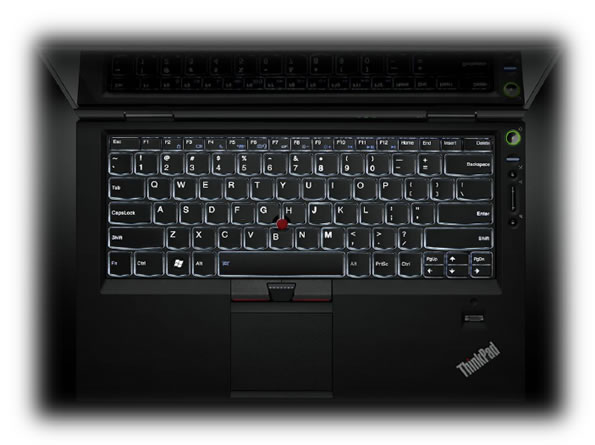Usage, Battery Life and Closing Thoughts
One key feature missing from the X1 that we liked about the X220 is the IPS display. While the Corning Gorilla glass and "infinity" screen are nice features, the display can't hold a candle to the IPS display in terms of viewing angles. Observed independently, the horizontal angles are actually pretty good, but the vertical angles are bad in comparison. Thankfully it's easy to adjust the angle of the display, so this isn't as big of an issue as it could be. Aside from viewing angles, colors looked nice and text was crisp thanks to the 1366 x 768 resolution.
The keyboard on the X1 is one of the best I've seen on a ThinkPad. It starts with the chiclet keys that feel great as you type. Lenovo has managed to work in a backlit keyboard in addition to the spill-resistant design carried over from previous iterations. Key layout is good as well with Lenovo implementing their "legacy reduced" key delete and typical Fn / Ctrl placement.

I can also report that the touchpad is much improved over the X220's implementation. The problem I found on the X220 is that Lenovo integrated the mouse click buttons into the touchpad. The implementation was pretty bad and difficult to use. Lenovo has corrected that issue with on the X1 and although it's still not as good as dedicated click buttons, you can use it without becoming frustrated.
For those looking to forego the touchpad completely, the TrackPoint and its dedicated click buttons are a viable option, especially for ThinkPad veterans.
Intel's Core i5-2520M performed as anticipated. We had an idea of what to expect from the X1 since our X220 sample came equipped with the same processor, memory and hard drive. 1080p full screen videos on YouTube only taxed the CPU around 15%. The 4k resolution video that we tested with on the X220 also taxed the X1 for roughly the same amount of cycles, around 80% CPU utilization.
The downward-firing speakers are up to the task as well. Audio can be played pretty loud and sounds just fine when bouncing off of a hard surface. Playing music with the system on a bed or sofa will result in less noise as the cushion below it will undoubtedly absorb some of the sound.

Heat generation and fan noise are both kept to a minimum even under full load. The system is very quiet at idle and just marginally louder under full load. At full load, the bottom back and left side do get warm but again, not overly so. The cooling fan seems to do a respectable job and keeping things under control, while part of the credit also goes to Sandy Bridge and its 32nm power-conscious architecture.
Connectivity options have also been improved on the ThinkPad X1. Noticeable additions include a USB 3.0 port, eSATA port and HDMI out. This is one of the few notebooks I have used that doesn't have a VGA port, however.
I conducted a few different battery tests using the internal 6-cell battery. Our video playback test consists of looping a 720p rip of one of my favorite movies (Inception) in Windows Media Player at full screen with max screen brightness and Wi-Fi disabled. This is a taxing test that resulted in 2 hours and 43 minutes of usage with the single battery.

Our endurance test is run with five Firefox windows open with the Reload Every add-on refreshing each page every 5 minutes to simulate real-world browsing. Max screen brightness is used and Wi-Fi is enabled. This test resulted in 3 hours and 23 minutes of life. We anticipate that decreasing the screen brightness to the default setting will likely meet the 5 hours Lenovo claims the X1 is capable of on normal use. The X1 also has the external slice battery option similar to the X220's, but we had issues testing our unit with it. If it's anything similar to the X220, this will result in doubling the battery life at the expense of additional weight and thickness.
Lenovo advertises that the X1's RapidCharge feature can charge the laptop's battery up to 80% in 30 minutes. In the single test we performed we had a completely dead system in hibernation when we started, then unplugged at 30 minutes and booted up to find 85% battery life. Seems spot on with their claims. This can be handy if you need a quick refill between connecting flights or while waiting between classes or during lunch.
If you can live without the fabulous IPS display found on the X220, the new ThinkPad X1 is a great notebook. The hardware under the hood is plenty powerful to keep the system relevant for some time to come. The thin frame, infinity display, backlit keyboard, Trackpoint and trackpad are all positives on this system. An SSD upgrade on the X1 would really wake the system up and ensure a snappy computer for the long haul, granted you can afford the upgrade cost and sacrifice disk space. Battery life, however, was lower than expected.

Outstanding product: Lenovo ThinkPad X1 ultraportable
Our price as reviewed is $1400, which seems to be carrying a small premium over similar machines. When compared directly with the X220, you are paying $100 extra for the same internal hardware, a larger but lower quality non-IPS display, a better keyboard and touchpad and a thinner (yet heavier) chassis. A similarly spec'ed Sony VAIO S can be had for around $200 cheaper, but the Sony adds a built-in optical drive and a basic discrete GPU. Meanwhile, the MacBook Air is similarly priced, is lighter and comes stock with a SSD, but still relies on the older Core 2 Duo processor series.